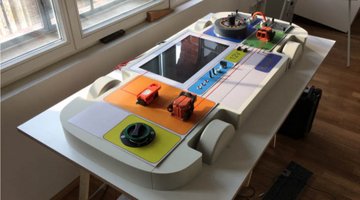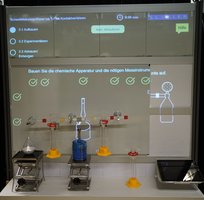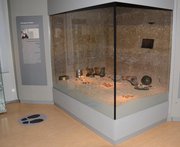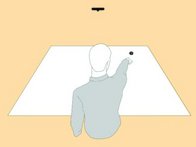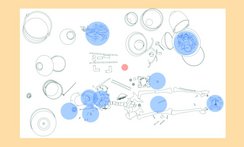This page predominantly lists funded research projects and dedicated PhD projects. Besides of these, we conduct research via theses student work and individual (unfunded) projects, e.g. on the design of interactive toys for children, alternative visions for smart homes, museum installations, neurodiversity, ambient and pervasive displays, etc.
»Futuring Machines. Practice-based exploration of AI as algorithmic irritation in the context of participatory futures«
Future-oriented, resilient societies require a critical engagement with possible futures. Using an interdisciplinary, practice-based approach, the project Futuring Machines investigates the potential of Human-AI interactions as disruptive thought-provoking impulses to facilitate critical reflection on future scenarios and foster perspective change through the writing of fictions and imaginary stories. To this end, the interdisciplinary team aims to iteratively optimize a large language model and develop an AI-supported writing tool that will be deployed in participatory workshops with diverse actors.
The 1-year project is funded by the Fellowship Forschungswerkstatt of the Bauhaus-Universität Weimar and started on 1.1.2024.
Project team:
Jordi Tost, M.A. — PhD student Faculty Art & Design, associated with HCI group, Fac. of Media
Dr. Johannes Kiesel — PostDoc Professorship Intelligent Information Systems, Fac. of Media
Mattis Kuhn, Dipl. Des. — Artistic Staff, Professorship Cross-media Moving Image, Fac. of Art & Design
Prof. Dr. Eva Hornecker — Professor of HCI, Fac. of Media
Marcel Gohsen, M.Sc. — Research Assistant Professorship Intelligent Information Systems, Fac. of Media
Maximilian Heinrich, M.A. — Research Assistant Professorship Intelligent Information Systems, Fac. of Media
External members:
Britta Schulte (PhD) — Research Assistant Anhalt Univ. of Applied Sciences
Fidel Thomet, M.A. — Research Assistant Urban Complexity Lab, Potsdam Univ. of Applied Sciences
Two Futuring Machines events in June!
How will we live in 50 years? The >Futuring Machines< project has been busy developing the user interface and different modes of co-writing. It now runs the first set of workshops where participants will be cowriting speculative fiction with AI. We'll imagine future scenarios, reflect on possibilities, fears and hopes, and put this all into short stories, supported by the AI-based co-writing tool that developed by the team.
The first workshop »Zukünfte schreiben mit KI« will take place during the 'Night of Writing' on 13th June at the University Library of BUW (Session 1: 19:15 bis 20:45; Session 2: 21:30 bis 23:00) in the PC-Pool of the Library. Registration here
The second workshop »Queer Futures schreiben mit KI« will take place during the Campus Pride Week on 18th June (Session 1 — 14:00 bis 16:00 ; Session 2 — 17:00 bis 19:00) SCC PC-Pool 2. Registration: here
BMBF Project GROOVE - experienced synchronisation for remote intimacy in social VR
Social Virtual Reality provides extended potential for remote interactions between partners across a distance, families and friends.How can interactions that foster social intimacy be further improved in virtual spaces? This is the focal point of the GROOVE research project that teams from the professorships of HCI, VR and Usability at BUW will work on together with researchers from the Technischen Universität Ilmenau, Brandenburg Labs GmbH and Consensive GmbH. GROOVE is funded by the German Federal Ministry of Education and Research (BMBF) over the »Nähe über Distanz - Mit interaktiven Technologien zwischenmenschliche Verbundenheit ermöglichen« funding programme. The HCI team leads the 3-year GROOVE project.
The German long name is 'GROOVE - Erlebte Synchronisation für Verbundenheit und Nähe in sozialer virtueller Realität'. University announcement page.
Project Web Page: https://www.uni-weimar.de/en/media/research/projekte/groove/
Research on Data Physicalization
What if data moved off the screen, with 3D physical shape and materiality? Ongoing research investigates Data Physicalization - physical artefacts whose geometry or material properties encode data. Building on past experience from Trevor Hogan's 'Tactile Data' PhD we have pursued this further, in student projects, as Hannes Waldschütz' and Rosa van Koningsbruggen's research focus and with the DFG Project FluidData on the UX of DataPhys.
- SS 2018 Data Driven Objects (student research project): Trommelwirbel + Bellum Omni contra omnes (war of all against all)
- WS 2018/19 Data Matters - Physical data representation through kinetic artifacts (student research project): The Sixth Wave
- WS 20/21 Data Perspectives. Physical Representations of Everyday Data (student research project)
- WS 21/22 Data Physicalization of Hidden Data (seminar+practical, joint course with LMU and Uni Regensburg run online)
- WS 22/23 A touch of data. Designing haptic data physicalisations of personal data (student research project)
- WS 23/24 Queer(y)ing Data: Re-Imaging and Re-Designing Personal Data (student research project)
- SS 24 Data driven Objects (another student project)
- van Koningsbruggen, Haliburton, Rossmy, George, Hornecker, Hengeveld. Metaphors and `Tacit' Data: the Role of Metaphors in Data and Physical Data Representations. ACM TEI 2024 Proceedings.
- Hornecker, Hogan, Hinrichs, van Koningsbruggen. A Design Vocabulary for Data Physicalization. ACM Transactions on Computer-Human Interaction, Volume 31 Issue 1, Article No.: 2
- Wang, Segal, Klatsky, F. Keefe, Isenberg, Hurtienne, Hornecker, Dwyer, Barrass. An Emotional Response to the Value of Visualization. IEEE Computer Graphics & Applications Magazine, Visualization Viewpoints, Vol.: 39, Issue:5, Sept/Oct. 2019. pp. 8-17. DOI: 10.1109/MCG.2019.2923483
DFG Project FluidData - The User Experience of Novel Pneumatic Shape-Changing Interfaces for Dynamic Data Physicalization
March 2020 our new DFG Project FluidData started. This investigates the potential of dynamic shape-changing interfaces for data representation. The project has a constructive-technical and an empirical strand. Project staff: Hannes Waldschütz and Rosa van Koningsbruggen.
On a constructive-engineering level, we will realize controlled shape change via pneumatically actuated (fluidic) membrane structures from textile/elastomeric material (inflatables) and explore the novel options this offers for shape-change and interaction. For this, we build on and collaborate with Kristian Gohlke's ongoing PhD work. The empirical focus of this project is on the user experience of data physicalization (especially with shape-change). While other research teams have begun investigating performance and accuracy in Data Physicalization, we believe that beyond pragmatic and utilitarian factors (i.e. usability), there are qualities and benefits related to user affect, sensation and meaning, i.e. UX. For some usage situations, this might be more important for increasing engagement and empathy with data. We will thus investigate terms of qualities and interpretations ascribed to a representation, as well as sense-making processes evoked, including the potential to raise empathy.
- Waldschütz, van Koningsbruggen, Hornecker. pneuCNTRL: a Pneumatic Control System for User Studies on Dynamic, Haptic Inflatables. Proc. of ACM TEI 2024, Work in Progress
- Waldschütz, Hornecker. Inflatable Textures: Creating Dynamic Haptic Surfaces with Inflatables. Proc. of ACM TEI 2024, Work in Progress
- Mahecha Arango, Ovais, Youssef, Das, van Koningsbruggen, Hornecker. `A Fair Game?': Using Narrative Sensification and Embodied Metaphors for Awareness. Proc. of ACM TEI 2024
- Gohlke, Waldschütz, Hornecker. WireShape - A Hybrid Prototyping Process for Fast & Reliable Manufacturing of Inflatable Interface Props with CNC-Fabricated Heat–Sealing Tools. Proc. of the 8th ACM Symposium on Computational Fabrication (SCF '23). Article 7, 1–8.
- van Koningsbruggen, Shalawadi, Hornecker, Echtler. Frankie: Exploring how Self-Tracking Technologies can go from Data-Centred to Human-Centred. Proc. of ACM MUM'22. ACM DL
- Dodani, van Koningsbruggen, Hornecker. Birdbox: Exploring the User Experience of Crossmodal, Multisensory Data Representations. Proc. of ACM MUM'22. ACM DL
- Gohlke, Sattler, Hornecker. AirPinch – An Inflatable Touch Fader with Pneumatic Tactile Feedback. Proc. of ACM TEI 2022 (collaboration with RethiCare project) ACM DL
- van Koningsbruggen, Waldschütz, Hornecker. What is Data? - Exploring the Meaning of Data in Data Physicalisation Teaching. Proc. of ACM TEI 2022. ACM DL
- van Koningsbruggen, Hornecker. “It’s Just a Graph” – The Effect of Post-Hoc Rationalisation on InfoVis Evaluation. Proc. of ACM Creativity & Cognition2021 (C&C'21) (HONORABLE MENTION AWARD)
- López García, Hornecker. Scaling Data Physicalization – How Does Size Influence Experience? Proc. of ACM TEI’ 2021, ACM DL
- Ren, Hornecker. Comparing Understanding and Memorization in Physicalization and VR Visualization. Proc. of ACM TEI’ 2021, ACM DL
- Waldschütz, Hornecker. The Importance of Data Curation for Data Physicalization. DIS’ 20 Companion Proceedings, 293–297. ACM DL
- Waldschütz, Hornecker, Fischer, Temme, Alnayef, Shalawadi, Ren. Drum Roll: A Data Physicalization of Real-Time Radiation Sensor Readings. DIS’ 20 Companion Proceedings, 477–479. ACM DL
Feminist Values in Tech Design
Any technology created carries the values embedded in its design. Technological innovations from male-dominated teams often result in products that overlook or neglect the perspective, experience and needs of female and non-binary users - as well as that of other non-represented or marginalized user groups. Some of these issues can be traced to the design and development process and practices. In this project, we explore the influence of embedding Feminist Values in technology design and development, focusing on methodology. First step approaches the exploration of the current field of methodology and applications, while the goal is to explore and potentially develop effective approach to designing technology with Feminist Values in focus from idea and requirements exploration up to product design, test and launch.
This is the PhD project of M.Sc. Margarita Osipova supervised by Prof. Eva Hornecker. Current project members: B.Sc. Konstantina Marra. Publications:
- Osipova, Hornecker. Exploring the potential for Smart City technology for Women’s Safety. Proc. of Academic Mindtrek Conference (Mindtrek ’23), ACM NY 2023, 17 pages.
- Sarkar, Marra, Osipova. Exit Violence: Comparing Usability of Physical and Visual Alarm Buttons in SOS App in the Context of Domestic Violence. Mensch und Computer 2023 - Workshopband. GI e.V.
- Jeon, Ebeling, Osipova: Empowering Safety Technology for Women’s Solo Journeys: Insights from a Story Completion Study. Mensch und Computer 2023 - Workshopband. GI e.V.
Participation Call for December23/January-March24:
We invite experts working with Feminist Values in research and industry (our focus is not limited to just gender-related, gender specific or FemTech, as long as your work – ongoing or former – covers at least a perspective or practical use of Feminism or Feminist Values in relation to technology). Contact us for participating via email to margarita.osipova[at]uni-weimar.de with a topic “Feminism and Technology”. You can also email her with questions, ideas and recommendations, or collaboration proposals.
SmartHomes - and not so Smart Homes
Our research repeatedly touches upon questions related to smart home technologies, or more generally to technologies in the home context. This is sometimes through student projects and theses (e.g. 'Living with Robots – The Future of Autonomous Machines in the Home', 'Technology in the Home', and 'Cushioning the Technology – Combining technologies and textiles for the smart home').
Tangible Interaction with Digital Information on Natural Surfaces (2021 - ongoing)
This is the PhD project of Annika Schulz, in collaboration with Robert Bosch GmbH and Hochschule Offenburg, co-supervised with Dr. Frank Beruscha (CR/ADT5), Robert Bosch GmbH and Prof. Dr. Oliver Korn, Affective & Cognitive Institute (ACI), Hochschule Offenburg.
- Schulz, Müller, Beruscha. Experience by Cohabitation: Living in a Smart Home Initiated by Your Partner. Proc. of INTERACT 2023. Lecture Notes in Computer Science, vol 14144. Springer, Cham.
- Schulz, Hornecker. Can you please cover both the "smart" and the "home"? Exploring expectations on smart homes considering changing needs. Proc. of ACM MUM'22. ACM DL
- Breunig, Calderón Arias, Mudavanhu, Syal, Schulte, Hornecker. Carpet Tiles: Interactive and modular smart textiles to support international students in shared dorms to feel at home. Proc. of MuC '21: Mensch und Computer 2021. pp 140-144. ACM DL.
- Kiesel, Lang, Wachsmuth, Hornecker, Stein. Investigating Expectations for Voice-based and Conversational Argument Search on the Web. Proc. of 2020 Conf. on Human Information Interaction and Retrieval (CHIIR ’20), 53–62. ACM DL.
- Honauer, Moorthy, Hornecker. Interactive Soft Toys for Infants and Toddlers – Design Recommendations for Age-appropriate Play. Proc of CHI PLAY '19. ACM NY, 265–276. ACM DL
RethiCare (funded by VolkswagenStiftung) (begin 2019)

RethiCare (Rethinking Care Robotics) is led by the HCI group and is a joint interdisciplinary project with BUW's Product Design area (Prof. Wolfgang Sattler), the University of Southern Denmarks Robotics group at The Maersk Mc-Kinney Moller Institute (Prof. Norbert Krüger) and sociologist Dr. Andreas Bischof at TU Chemnitz. RethiCare will explore the design space of non-anthropormorphic, robotic helper machines and devices (which, for instance, integrate with everyday objects and furniture) for the context of care homes. It started April 2019, with 3 years funding, and was extended until early 2023.
To re-shape research and design practices and to develop alternative visions for robots in care, new interdisciplinary collaborations and new methods of design and evaluation are needed. The project's interdisciplinary constellation will enable us to re-think from the ground up what care-robotics should look like and ‘do’, using contemporary design methods in a rapid prototyping, design-driven approach. It will apply a user-centered, creative design and development approach in close collaboration with users (2 care institutions as associated partners), guided by principles of universal design, flanked with an integrated science-technology-studies perspective. (University Press-Statement)
-> Project Website
- Graf, Zarp, Naik, Lefeuvre, Marchetti, Hornecker, Sørensen, Hemmingsen, Christensen, Bodenhagen, Krüger, Bischof. Distributed Agency in HRI -An Exploratory Study of a Narrative Robot Design. Frontiers in Robotics and AI. Sec. Human-Robot Interaction. Vol. 11 - 2024. doi: 10.3389/frobt.2024.1253466
- Kollakidou, Lefeuvre, Sønderskov Zarp-Falden, Malbois, Bodenhagen, Krüger, Hornecker. Bibo the Moving Cup for People Affected by Dementia: Design, Ethical Considerations, and First Observations in Use. SN Computer Science. 4:432 (2023). link
- Schulte, Hornecker. Care Stories: Understanding People’s Hopes and Fears for Technologies of Care through Story Elicitation. Proc. Academic Mindtrek 2022. ACM 117–128. ACM DL.
- Marchetti, Grimme, Hornecker, Kollakidou, Graf. Pet-Robot or Appliance? Care Home Residents with Dementia Respond to a Zoomorphic Floor Washing Robot. Proc. of CHI 2022, ACM DL.
- Bischof, Hornecker, Graf, Franzkowiak. Integrierte Roboterentwicklung für die Pflege. Konzeptuelle und praktische Herausforderungen am Beispiel ReThiCare. TATuP – Journal for Technology Assessment in Theory and Practice, Vol. 31 No. 1 2022 pp. 48-54
- Hornecker, Krummheuer, Bischof, Rehm. Beyond dyadic HRI: building robots for society. interactions 29, 3 (May - June 2022), 48–53. ACM DL.
- Bischof, Hornecker, Krummheuer, Rehm. Re-Configuring Human-Robot Interaction. In Proceedings of the 2022 ACM/IEEE International Conference on Human-Robot Interaction (HRI '22). IEEE Press, 1234–1236.
- Graf, Lefeuvre, Palinko, Naik, Zarp, Bischof, Hornecker, Krüger. Fostering well-being in care with the nautical designed Plant Watering Robot. Proc. HUCAPP'22.
- Lefeuvre, Graf, Hornecker. Designing A Robot for Elderly Care Homes based on the Notion of 'Robot as Theatre'. Pictorial. Proc. Mobile and Ubiquitous Multimedia (MUM 2021). ACM, pp 242–251. ACM DL
- Kollakidou, Lefeuvre, Sønderskov Zarp, Palinko, Krüger, Hornecker. Bibo the dancing cup: Reminding people suffering from dementia to drink. Proc. of ICT for Health, Accessibility and Wellbeing (IC-IHAW 2021), Springer
- Grimme, Kollakidou, Sønderskov Zarp, Hornecker, Kruger, Marchetti. Don’t be afraid! Design of a playful cleaning robot for people with dementia. Proc. of ICT for Health, Accessibility and Wellbeing (IC-IHAW 2021), Springer
- Palinko, Graf, Naik, Lefeuvre, Zarp, Krüger. Intention Signaling for Mobile Social Service Robots – The Example of Plant Watering. Proc. of Social Robotics. ICSR 2021. Springer LNCS. 10.1007/978-3-030-90525-5_74.
- Schulte, Graf, Franzkowiak, Hornecker. Hospital beds, robot priests and huggables: a (fictional) review of commercially available care robots. Proc. ACM NordiCHI 2020. Article No.: 43 ACM DL.
- Hornecker, Bischof, Graf, Franzkowiak, Krüger. The Interactive Enactment of Care Technologies and its Implications for Human-Robot-Interaction in Care. Proc. ACM NordiCHI 2020. Article No.: 78 ACM DL.
Re-thinking CareRobots (Planning Grant), VolkswagenStiftung
In January 2018 we received a small grant from VolkswagenStiftung aimed to support preparation for a full funding proposal on 'rethinking care robotics' (which was successful). As part of the preparations, we (Prof. Sattler, Product Design program and us) co-taught a student project on technology in care. Our future project partners traveled to Weimar for proposal discussions, and were also invited into the student project and for the Bauhaus.Interaction Colloqium, all helping us to immerse deeper into the topic. We also attended a conference on care technology ('Zukunft der Pflege') in Oldenburg with the entire project group, which was a great experience for all.
Exploring Bio-Inspired Soft Fluidic Actuators and Sensors for the Design of Shape Changing Tangible User Interfaces.
Kristian Gohlke's PhD investigates fluid actuators (also known as soft robotics), mainly in form of pneumatically actuated soft or malleable material mechanisms as well as the use, application potentials and the limitations of such systems for interaction design. By contributing to a novel category of interfaces that are malleable, inherently capable of isotropic shape change and mechanically compliant, the research further intends to question the fundamental design paradigm of current technological artifacts that are commonly characterized by fixed form factors, rigid mechanisms and static enclosures.
This research has overlapped with some work in the RethiCare project and in FluidData, which looks at application areas for pneumatically actuated shape-change through inflated sheet materials, with Hannes Waldschütz as main researcher. key publications:
- Gohlke, Sattler, Hornecker. AirPinch – An Inflatable Touch Fader with Pneumatic Tactile Feedback. Proc. of ACM TEI 2022. Article 64, 1–6. ACM DL
- Gohlke, Hornecker. A Stretch-Flexible Textile Multitouch Sensor for User Input on Inflatable Membrane Structures & Non-Planar Surfaces. Adjunct Proc. of ACM UIST 2018. ACM DL
- Gohlke. Exploring Bio-Inspired Soft Fluidic Actuators and Sensors for the Design of Shape Changing Tangible User Interfaces. ACM TEI 2017 Graduate Student Consortium, ACM DL.
- Gohlke, Hornecker, Sattler. Pneumatibles – Exploring Soft Robotic Actuators for the Design of User Interfaces with Pneumotactile Feedback. Proc. of ACM TEI 2016, pp. 308-315. author pdf and ACM DL
Interactive Costumes - How Wearables and E-Textiles can enter Performance Stages
Michaela Honauer's PhD project investigated wearables and e-textiles in the specific domain of professional stages that have predefined infrastructures and expertise-based hierarchies (e.g. theatre, ballet, opera). Next to the technical challenges for particular use cases, Michaela searches for solutions that help to integrate the production and staging processes of interactive costumes into traditionally grown structures. Her practice-based research is ethnographically motivated and tries to establish working routines and connections to practitioners as well as theatre, opera and ballet houses. Michaela defended her PhD in mid 2022 and is now a PostDoc at the Univ. of Twente.
- Honauer. Beyond costume tradition and physical computing: Characterizing the profile of interactive costume creators. Digital Creativity 2021, DOI: 10.1080/14626268.2021.1922459
- Honauer, Wilde, Hornecker. Overcoming Reserve – Supporting Professional Appropriation of Interactive Costumes. Proc. of ACM DIS ’20, 2189–2200. ACM DL. pdf. (BEST PAPER AWARD)
- Honauer, Hornecker. Challenges for Creating and Staging Interactive Costumes for the Theatre Stage. Proc. of Creativity & Cognition 2015 (C&C'15). ACM, pp. 13-22. ACM DL
- Honauer. Designing (Inter)Active Costumes for Professional Stages. In. Schneegass, Amft (eds.) Smart Textiles. Springer Intern. Publishing 2017, 10.1007/978-3-319-50124-6 chapter 13, p. 279-302
- Honauer. Designing Interactive Costumes: Challenges and Prospects to Integrate Computational Clothing in the Performing Arts. ACM DIS 2017 Doctoral Consortium, ACM DL.
- Honauer, Wiegert, Sohaib, Cárdenas Monsalve, Zhao, Effenberg, Alshomary, Hornecker. Mermaids do not exist? Interactive Costumes do! Proc. of ACM MUM 2017, 535-540. Arts Track, ACM DL
- Martinez, Honauer, Sandhaus, Hornecker. Smart Textiles in the Performing Arts. In: Textiles, Identity and Innovation. Proc. of 1st Int. Textile Design Conference (D-TEX 2017), Lisbon, 2‐4 Nov. 2017,
- Honauer. 2018. Designing a Remote-Controlled Interactive Dance Costume. Proceedings of Int. Conf. on Movement Computing (MOCO’18), 6 pages. ACM DL
Tangible Data: The Role of Embodiment in Physical Data Artefacts
Trevor Hogan's PhD project investigated tangible and multi-sensory data representation and the role of embodiment in the user experience of physical data artefacts, taking a phenomenological perspective. > tactiledata.net.
We are continuing this collaboration together with Uta Hinrichs following Trevor's PhD graduation and are now investigation physicalization, that is physical data representations (see other entry). key publications:
- Hogan, Hinrichs, Hornecker. The Visual and Beyond: Characterizing Experiences with Auditory, Haptic and Visual Data Representations. Proc. of ACM DIS 2017, 797-809. author pdf and ACM DL
- Hogan, Hinrichs, Jansen, Huron, Gourlet, Hornecker, Nissen. Pedagogy & Physicalization: Designing Learning Activities around Physical Data Representations. Workshop. Companion Proc. of ACM DIS'17. 345-347. ACM DL. Workshop website
- Hogan; Hornecker. Towards a Design Space for Multisensory Data Representation. Interacting with Computers Vol. 29, Issue 2, March 2017, pp. 147–167, First published online: May 20, 2016; pdf-version, doi:10.1093/iwc/iww015
- Hogan, Hornecker. Feel it! See it! Hear it! Probing Tangible Interaction and Data Representational Modality. DRS2016, Design Research Society Conference in Brighton, UK.
- Hogan, Hinrichs, Hornecker. The Elicitation Interview Technique: Capturing People’s Experiences of Data Representations. IEEE Transactions on Visualization and Computer Graphics (online first 2015, print in 2016)
- Hogan, Hornecker. Blending the repertory grid technique with focus groups to reveal rich design relevant insight. Proc. of DPPI'13, Designing Pleasurable Products and Interfaces, ACM 2013, 116-125. Author version.
- Hogan, Hornecker. In Touch with Space: Embodying Live Data For Tangible Interaction. Proc. of TEI'13, ACM, 275-278. Author version.
ELIXIER - BMBF Project 'Erfahrungsbasiertes Lernen durch interaktives Experimentieren in erweiterten Realumgebungen' (finished)
The BMBF Project ELIXIER started May 2016. ELIXIER was to develop an augmented experimental lab workbench that provides context-oriented tutorial assistance (via embedded projections, sound output, etc.) and supports teachers in setting up experiments for class. The system enables intelligent connection of digital learning portfolios and practical lab experiments via a web-based infrastructure (seamless smart lab) so that learners can review their practical work anytime, anywhere in an interactive way. 3 scenarios were explored, with BUW involved in two: a workbench for chemistry experiments and a training setup for car mechanic apprentices regarding electro-motor cars.
The project collaborates with industry partners and research institutions, and covers technical infrastructure development, sensor tracking of experiment data, to didactical assistance, learning effectiveness and usability of augmented learning environments. BUW in this project focused on usability-oriented design and evaluation of augmented environments.
Project partners: Archimedes Exhibitions, Berlin (coordinator); FU Berlin; LD Didactic GmbH; Fraunhofer IDMT Ilmenau/Oldenburg
more information: BMBF announcement, project website
- Karsten, Jörg, Hornecker. Learner versus System Control in Augmented Lab Experiments. Proc. of ISS 2017 Interactive Surfaces and Spaces. 354-359. ACM. ACM DL
- Karsten, Jörg, Hornecker. Mixed Reality Demonstratoren für den Experimentalunterricht. Workshop Be-greifbare Interaktion at Conference Mensch&Computer 2017
- Kirstein, Hornecker, Grossmann, Nordmeier. Seamless Smart Labs. PhyDid B-Didaktik der Physik-Beiträge zur DPG-Frühjahrstagung
Urban HCI - Understanding Architectural Influences (finished)
Patrick Tobias Fischer's PhD work investigated how spatial configurations and architectural elements influence the use of public interfaces. Tobias submitted and defended his PhD at the University of Strathclyde in 2016. He continued this work at BUW, and for several years we explored how public interfaces can foster shared encounters, how to evaluate such interfaces, and engaged in a series of design-evaluation experiments. > Plazapuck preview key publications:
- Fischer, Hornecker. Urban HCI: Spatial Aspects in the Design of Shared Encounters for Media Faccades. Proc. of CHI 2012. ACM. pp. 307-316. pdf
- Fischer, Zöllner, Hoffmann, Piatza, Hornecker. 2013. Beyond Information and Utility – Transforming Public Spaces with Media Facades. Computer Graphics and Applications, IEEE, 33, 38-46. IEEE Explore DL, author version.
- Fischer, von der Heide, Hornecker, Zierold, Kästner, Dondera, Wiegmann, Millan, Lideikis, Cergelis, Verde, Drews, Fastnacht, Lünsdorf, Merat, Khosravani, Jannesar. Castle-Sized Interfaces: An Interactive Façade Mapping. Proc. of Pervasive Displays 2015 (PerDis'15), ACM 2015, pp. 91-97. doi
- Memarovic, Gehring, Fischer. 2015. ELSI Model: Bridging User Engagement around Interactive Public Displays and Media Facades in Urban Spaces. Journal of Urban Technology Vol. 22, Issue 1, 2015, pp. 113-131. DOI:10.1080/10630732.2014.942169 journal site
- Sahibzada, Hornecker, Echtler, Fischer. Designing Interactive Advertisements for Public Displays. Proc. of ACM CHI 2017. 1518-1529 ACM DL
- Fischer, Hornecker. 2017. Creating Shared Encounters Through Fixed and Movable Interfaces. In: Nijholt (ed). Playable Cities. The City as a Digital Playground. Springer Singapore, pp 163-185
- Fischer, Hornecker (2017). Media Architecture for Shared Encounters. In: Wiethoff, Hußmann (Eds.) Media Architecture. Using Information and Media as Construction Material. de Gruyter, Berlin/Boston, Age of Acess Series Vol. 8. 2017. p. 5-23
- Fastnacht, Fischer, Hornecker, Zierold, Ornelas Aispuro, Marschall. The Hedonic Value of Sonnengarten –Touching Plants to Trigger Light. Proc. of MUM 2017, 507-514. Video Track. ACM DL
Interactive Museum Installation – Touchless Interaction via Motion Tracking and Pointing Gestures (finished)
3D graphics are common in modern media, while two dimensional input techniques are used for interaction. A variety of devices are used in these contexts to manipulate contents which often are complicated or error prone. But meanwhile, home entertainment-systems can be operated just with hand gestures.
Master student Michael Pannier developed a novel interaction prototype where museum visitors are tracked with a motion sensor (ASUS XtionPRO) and analyzed via the OpenNI framework. A visitor can simply point at the artefacts within a showcase and the software will provide corresponding information on a screen. This provides a low cost and low-maintenance system. Our system also allows the museum staff to set up a new installation, to define and edit the objects of interest within it as well as attach corresponding information, i.e. text and images to be shown on a screen whenever a user points at the artefacts. A particular challenge in this project has been to adapt Kinect-like motion sensing technology to determine pointing targets on a horizontal plane (instead of a vertical screen), to account for angular error, eye-hand visibility mismatch, and pointing inaccuracy.
We collaborated with the local museum of pre- and early history Thuringia (Museum für Ur- und Frühgeschichte Thüringens) to build a system for a showcase, containing the grave of a germanic princess, the 'Prinzessin von Haßleben'. This was installed in July 2014. Michael Pannier furthermore interviewed visitors before installation of the system and after to investigate whether it contributes to making the grave more memorable and increasing people's knowledge about it.



